How Accurate Was Vishal Sikka on the Future of HANA?
Executive Summary
- Vishal Sikka makes several false statements about HANA in this interview with Dennis Howlett.
- One of these is a hilarious proposal around curing cancer with genetic algorithms in HANA.
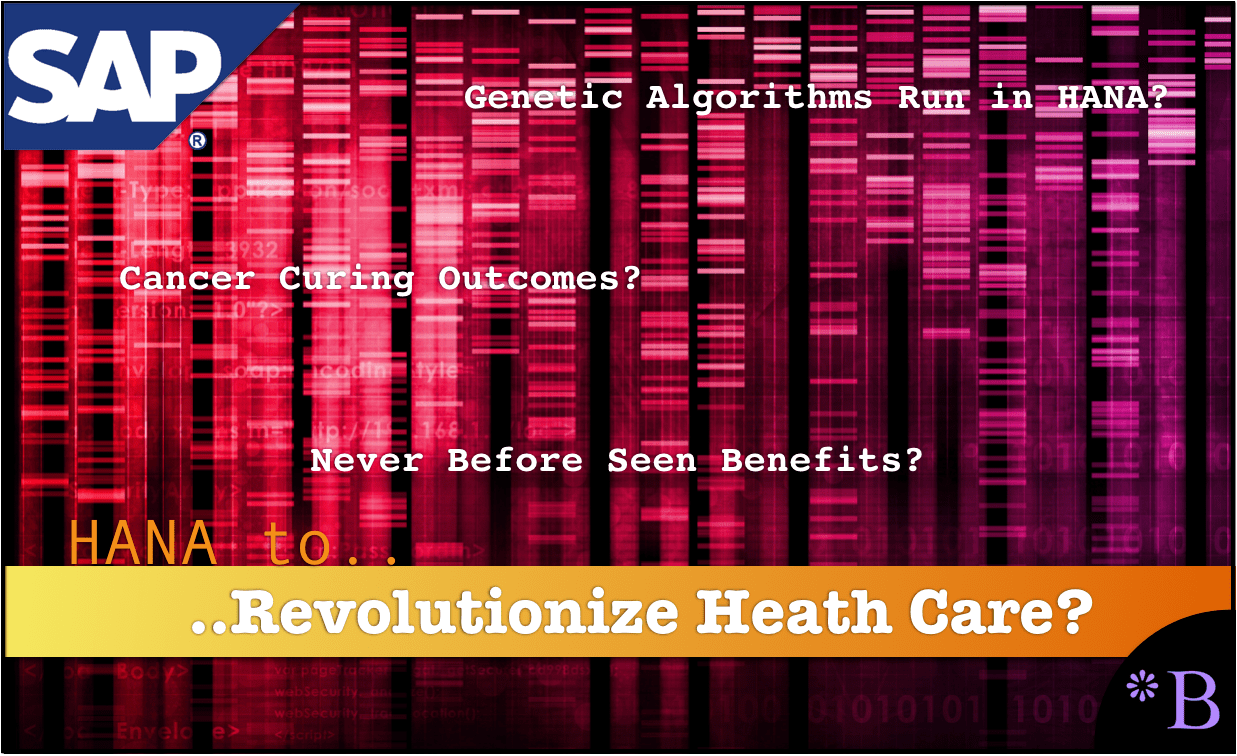
Video Introduction: How Accurate Was Vishal Sikka on the Future of HANA?
Text Introduction (Skip if You Watched the Video)
The video below was posted in 2012 and is an interview with Denis Howlett and Vishal Sikka. At this time Diginomica counted SAP as a sponsor. Naturally, this means that they received very biased coverage. Dinginomica interviewed Vishal Sikka who made some enormous claims about the future of HANA as well as proposing that SAP was greatly motivated by the desire to improve humanity. You will see our analysis of how accurate this video was and how much of what Vishal Sikka said came true.
Our References for This Article
If you want to see our references for this article and other related Brightwork articles, see this link.
Notice of Lack of Financial Bias: We have no financial ties to SAP or any other entity mentioned in this article.
The Video
Video Analysis
Vishal may have been a Ph.D., but everything he said in this and other quotations from him has turned out to be false.
Dennis Howlett, whose media entity receives income from SAP and who has a long pattern of not contradicting what SAP says, shows clear deference to Vishal Sikka. Even though even when this interview was performed, Vishal already had a long history of providing false information.
Hasso Weighs In
In a separate article, Hasso Plattner also promoted this solution in a paid placement in Fortune titled, Meet HANA, She’s SAP’s New Gold Mine.
Article Quotations
FORTUNE — “The fastest-growing product in SAP’s 40-year history isn’t a business software application, and it wasn’t invented within the German company’s massive research and development labs at the request of its co-CEOs. Rather, HANA, a new in-memory database technology capable of speeding up complex computations, was developed by a handful of university students and spearheaded by none other than SAP’s 69-year-old co-founder and chairman, Hasso Plattner. In the early days, HANA was known as “Hasso’s New Architecture”.”
HANA as the Fastest Growing SAP Product of All Time?
This is a story that SAP has been pushing, but it is inaccurate. The math behind why HANA could not be the fastest growing product in SAP’s history is covered in the article How Popular is HANA?
“A number of SAP’s (SAP, -0.61%) core business applications have already been rewritten to run on HANA. But Plattner, whose father was a doctor, is particularly excited about HANA’s prospects in the healthcare industry. Earlier this week, at a personalized medicine conference in Silicon Valley, he touted HANA’s abilities to quickly churn through massive amounts of medical information, like genomic data, in order to identify the best therapy for a patient. According to Plattner, SAP will launch a HANA-based healthcare platform in the “next few months.””
“Doctors are instant decision makers,” Plattner told the audience.” “And therefore the system has to be extremely fast.”
SAP’s Mystery Health System
This never occurred. If SAP ever released SAP Medical Research Insights, which we covered in the article How Accurate was Vishal Sikka on the Future of HANA?
Also, why does Hasso believe that doctors are instant decision makers? Is that actually how health care is delivered, through doctors who make instant decisions? Is Hasso speaking of the emergency room physicians or physicians overall? Furthermore, as we cover in the article Why HANA is a Mismatch for ERP and S/4HANA and What is the Actual Performance of HANA?, HANA has not been shown to have better performance than the competing offerings from other database vendors. Therefore, even if Hasso Plattner’s statement were true, which it isn’t, the point would be moot, as that performance benefit is better obtained from non-SAP databases.
Bill McDermott’s Weighs In, Predicts MASSIVE HANA Uptake
“HANA has quickly grown into a 392 million euro business for SAP, though it still comprises a relatively small percentage of the company’s total revenue. But SAP is already touting the uber-fast technology as a big success story. “You can see the acceleration,” co-CEO Bill McDermott told Fortune after the company announced its latest earnings report last week, adding that about half of HANA’s 2012 revenue came in the fourth quarter of last year. “It’s becoming a real brand, and a well-known solution. And guess what, we’re just getting started.””
Hasso’s Predictions on HANA’s Becoming 20% of SAP’s Revenues
Four and a half years later, HANA’s sales have been disappointing. Rather than push out Oracle, SAP has extended their partnership with Oracle into the foreseeable future, as is covered in the article SAP’s Change in Policy on HANA and Oracle.
“SAP expects sales of HANA to reach upwards of 700 million euros in 2013. Though the technology is promising, it requires companies—including SAP—to rewrite applications for the new platform, a time-consuming task. But Plattner says all of SAP’s current and future applications will be “HANA-rized,” and that the technology will someday soon make up at least 20% of SAP’s revenue.”
Four and a half years later, HANA is nowhere near 20% of revenues. SAP is a $20 billion a year company, so to do what Hasso proposed would mean HANA would have to have become a $4 billion business. According to DB-Engines, HANA currently sits as the 19th most popular database.
Larry Ellison’s Prediction on HANA
“Of course, Larry Ellison, CEO of database leader Oracle (ORCL, -0.18%), has a different take on HANA’s prospects. Last year he suggested Plattner must be on drugs to think he can compete with Oracle, saying his company has been working on in-memory technology for a decade.”
Larry turned out to be right.
“Plattner’s response: “I never took drugs in my life,” he said in an interview with Fortune earlier this week.”
SAP’s Growth into Health Care and Comparisons to Watson
“But SAP doesn’t have just Oracle to contend with. IBM (IBM, +0.02%) has already made a big push into healthcare with its Watson supercomputer, which relies on similar underlying technologies (like parallel processing) but also uses artificial intelligence to suggest diagnoses and therapies to doctors. Both technologies aim to comb through medical data much faster than a human physician can.”
HANA does not rely upon the parallel process. It relies on a combination of large amounts of memory in SSD and RAM combined with column-oriented table design, as covered in the article How HANA is Such a Fast Database (for Analytics).
Secondly, IBM’s Watson has been the subject of a major marketing campaign on the part of SAP, but it has not been a successful product for IBM.
4.5 Years Later Where is SAP’s Health Product?
I performed a search, and the term Health or Medical is not found in a single product in SAP’s 309 product database. So what is Vishal talking about?
Well, it turns out that there is a product called SAP Medical Research Insights, which is found at this link.
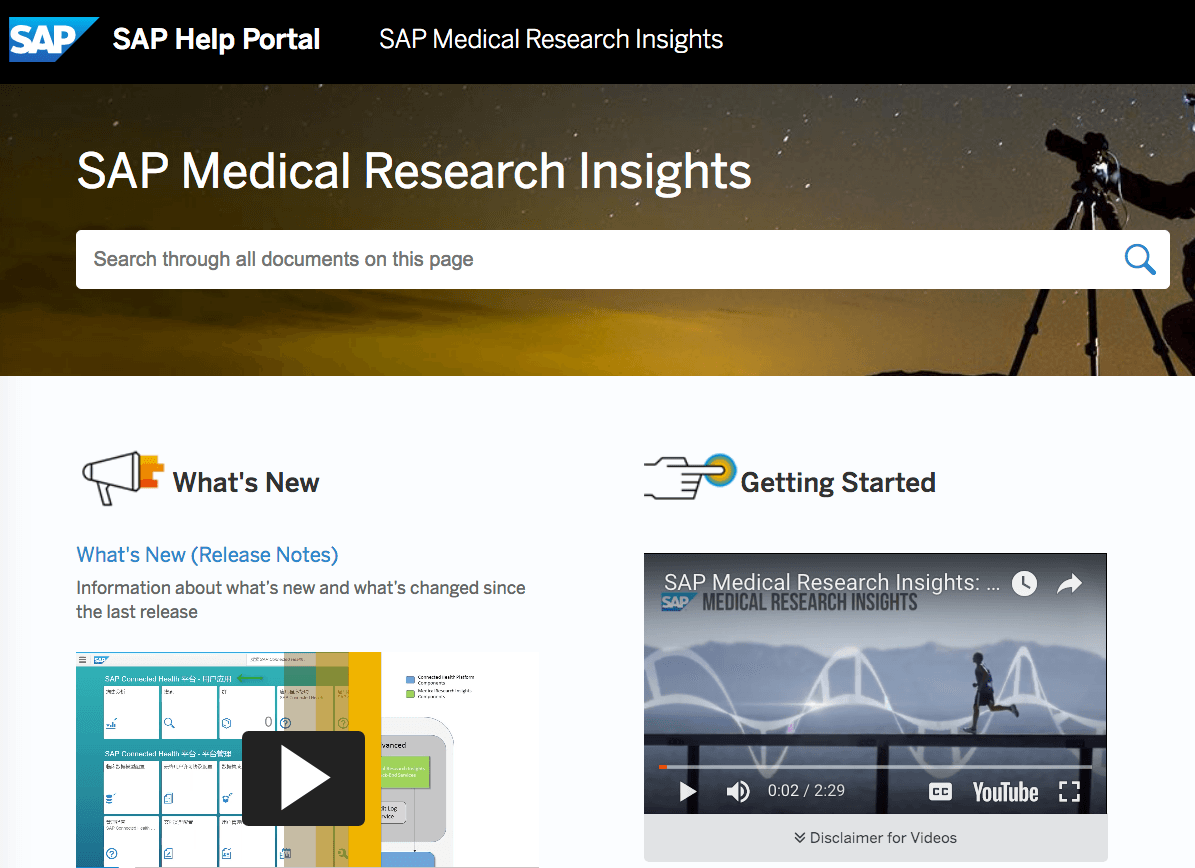
It is difficult to determine precisely how popular this is. SAP puts up a good front in some articles about SAP Medical Research Insights, which are covered by either paid placements or by publishing information through publications that the own (details to follow)
SAP has several universities that appear to be test sites, since 2012 how popular has this medical solution become. We do have a way of finding out.
Searching for Term Popularity
We use a program called KWFinder to determine the popularity of various keywords. Let us start by setting a baseline using other SAP terms to provide an understanding of how popular SAP terms are in general.
SAP HANA is a relatively popular database for SAP. That shows in the searches per month, which is 60,500.
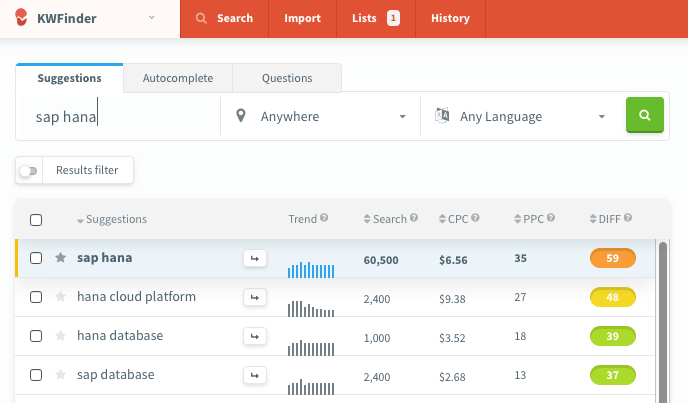
If we check for a keyword for an unpopular SAP application in a keyword tool, we come up with the following result.
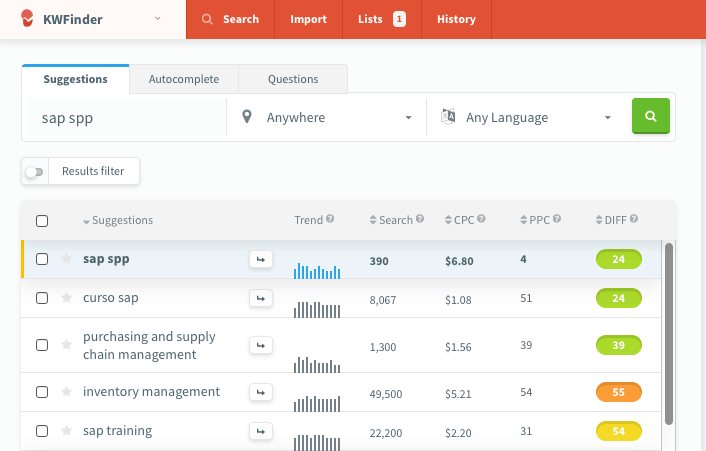
SAP SPP is an application that has dramatically declined in popularity since its introduction. Even a very unpopular product like SAP SPP has 390 searches per month.

SAP F&R is an application that was barely ever implemented, yet it still has 490 searches per month.
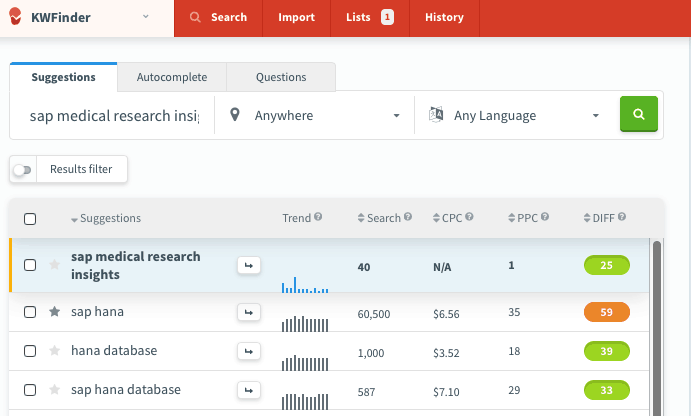
SAP Medical Research Insights has 40 searches per month. That is so small that it illustrates that SAP has had virtually no tracking with this offering.
Genetic Algorithms in HANA?
We just evaluated the popularity of the search term of the SAP product for medicine, but what about specific terms used by Vishal Sikka? That, it turns out, tells us a story as well.
The only other source I can find on this is in 2014 from the consulting company itelligence in the article Why Do We Need HANA which states…
“Here, for example, so-called genetic algorithms come into play. These are able to evaluate a forecasting model qualitatively. The data space in which I can move around here can be almost as large as I want. Many elements of modern AI research have been incorporated in the HANA function libraries. These include methods for machine learning as well as fuzzy logic and adaptive heuristic methods from bioinformatics.”
But, curiously, the only other reference would be the website of a consulting company. SAP consulting companies do not provide reliable information and are in our analysis, nothing more than marketing articles that try to promote SAP.
itelligence’s website is literally filled with inaccurate articles on SAP. itelligence’s partner company is NTT Data, which is covered in our article, The Propaganda in IT Award Goes to NTT Data on HANA.
Apparently, in the five years since Vishal Sikka’s statements, nothing at all has happened on genetic algorithms in HANA. That is for either the medical area or any other area.
Did Vishal Sikka simply make up the part about genetic algorithms in HANA? Were they working on it, and then nothing happened?
What is Dennis Howlett and Diginomica Enabling?
This entire interview has no pushback from Dennis Howlett and simply lets Vishal, who is known to have low accuracy in his statements, just spin a yarn. Just because cancer is a problem does not mean that SAP has the solution. These are two different topics. Playing on people’s empathy to confuse the issue of what the company has to offer to address the problem is the same strategy used by Theranos. It is the same strategy used by charities that bring up the issue of misery while keeping charitable donations. The answer to a miserable situation is not to give money to an entity that is misleading you about the solution they are providing.
Diginomica is sponsored by SAP. Therefore it should be no surprise that Dennis Howlett is not pushing back on Vishal.
Allowing Empathy to Cloud the Analysis
Bill McDermott does this as well in the following video by pointing out he lost his mother to cancer. This, not making more money, is Bill McDermott’s motivation for offering a product that will “improve” medicine and “improve” cancer treatment in particular.
Bill McDermott is very good at connecting with people using emotion to make a sale. He will use any way to connect to customers to make that sale, including declaring SAP’s interest in curing various diseases while Bill is an utterly cutthroat individual. He uses terms like “empathy” to manipulate people. He does this all the time. There is a video of him talking about how he lost his mother to cancer; you can see the video here.
If only Bill’s mom had HANA, HANA would have saved her. He and Vishal talked about how they were going to run genetic algorithms in HANA (must be run in HANA, not the application layer, or people will die of cancer.)
What is next, C/4HANA solves world hunger. How about Qualtrics with ML to stop human trafficking??
Interestingly, the SAP health solution never materialized, and people are still dying of cancer. My uncle is going through chemotherapy currently, and my stepbrother died of brain cancer, but it never occurred to me to try to sell some databases from this problem.
This makes the listener lower their guard and be more willing to do what Bill McDermott wants. The problem is that Bill McDermott provides a great deal of inaccurate information in his presentations.
By the way, this video was hosted in an article published by Digitalist Magazine. This text was at the bottom of that article.
“Article published by David Delaney. It originally appeared on SAP and has been republished with permission.”
That means that SAP itself originally published the article. Upon investigation, it turns out that Digitalist is itself an SAP publication, so it is a propaganda outlet for SAP. Therefore, nothing accurate can be expected to come from Digitalist.
Is SAP’s Medical Research Insights Anything but Standard Analytics?
Vishal Sikka spoke about cancer diagnostic genetic algorithms.
But Is SAP’s Medical Research Insights looks like a generic analytics system that is applied to medical research.
In this video, a researcher is brought to an SAP conference to demonstrate the analytics.
The researcher makes it seem as if these things are unique to HANA or the SAP Medical Research Insights. But in fact, they are generic types of analytics that don’t show off any of the particular capabilities of a column-oriented data store. The amount of data being processed is small.
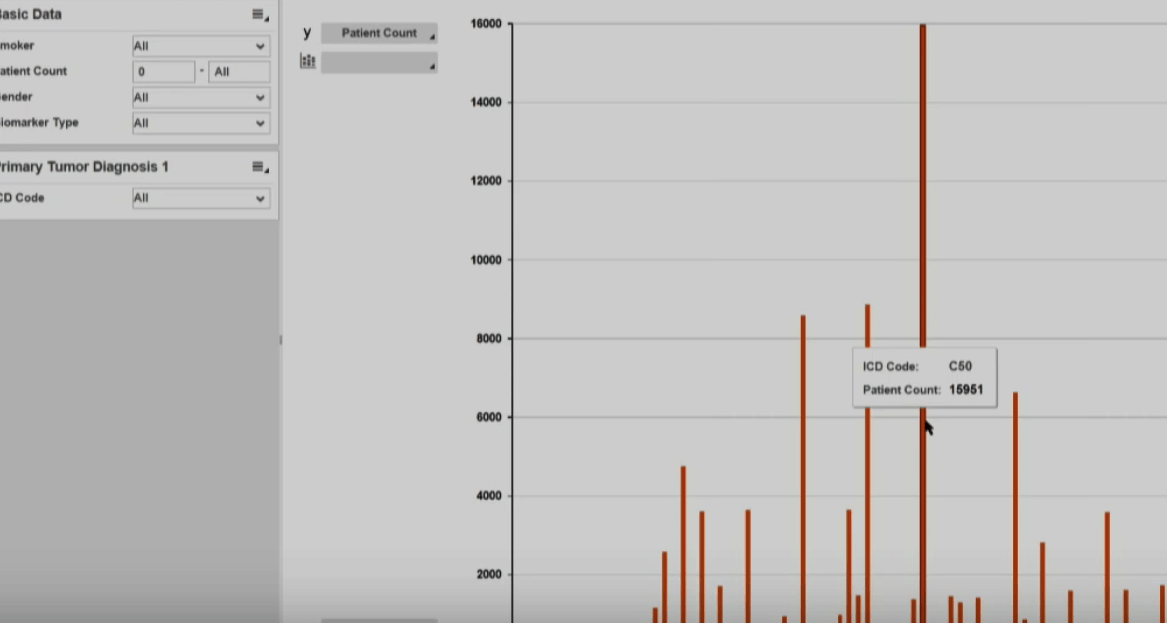
This screenshot from the same video shows that the number of patients being processed is 15,951. Is this a test for a highly expensive database like HANA. Why can’t this be processed on a laptop? Is a server even required for this? Is a database even necessary? I have processed far larger datasets than this using an old laptop and using Excel.
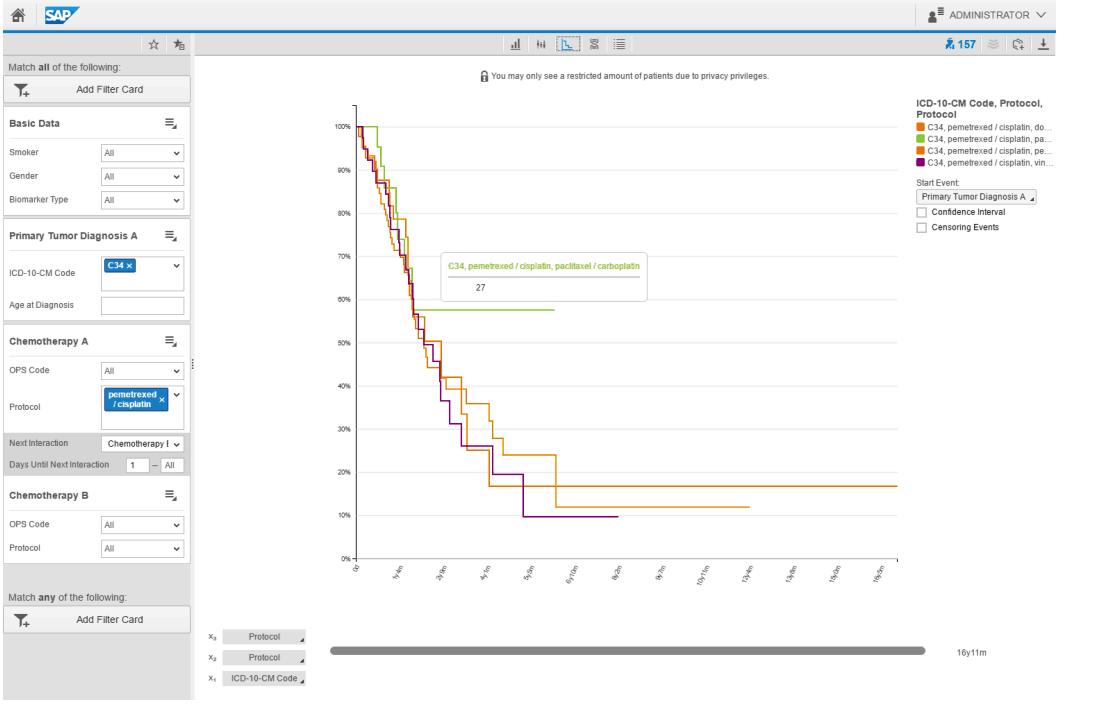
Here is another screenshot of SAP Medical Research Insights from SAP’s document Getting Started Guide for SAP Connected Health
Platform and SAP Medical Research Insights.
Graphics of this level of complexity can be generated off of spreadsheets as data stores, why would HANA be required here?
SAP Playing with the Term Biostatistics
SAP uses the language of biostatistics to make an impression, as the following quotation attests.
“Imagine you work for the Cancer Genome Atlas Research Network, which is exploring multiple cancer types to identify molecular biomarkers. It has been shown that genetic variations correlate with treatment outcome, prognosis, or toxicity of drugs (emphasis added). A recent publication demonstrated that mutations, for example on the gene TP53, show strong correlation of recurrence and disease prognosis. Here we want to investigate how this finding could be potentially reproduced and used in our particular patient cohort.”
Right, so this is a problem of correlation, which is often managed with regression. This can also be done in Excel. The resulting screen that SAP shows is the following:
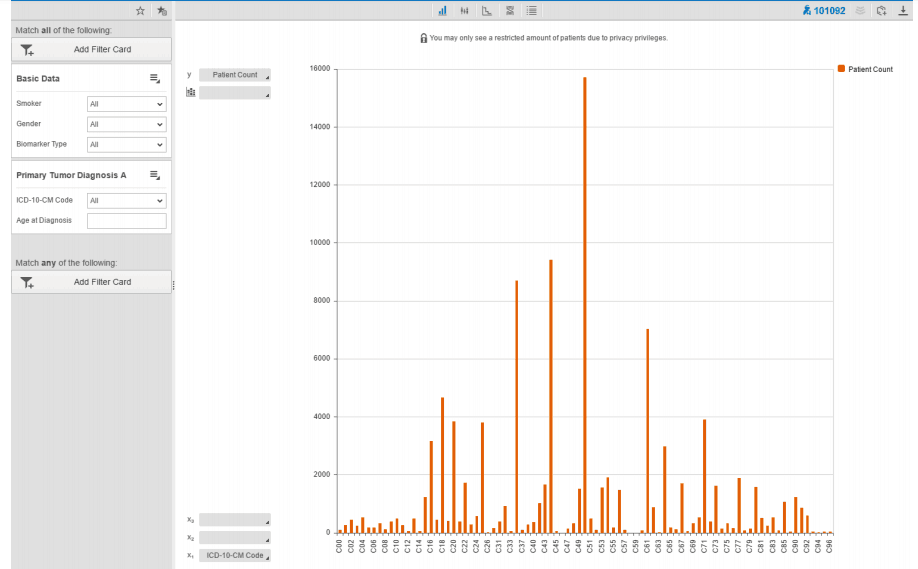
So SAP shows us a bar chart. Then SAP shows drilling into any bar to see the detail. Very standard analytics functionality. Nothing specific to the medical field at all.
The viewer is supposed to accept the assumptions presented by SAP that something unique was developed with SAP Medical Research Insights. But if you watch the video and read SAP documentation on SAP Medical Research Insights in detail, it does not look like that at all.
One view that does seem to be specific to bio-medical is the following:

This is different than analytics views we have seen on projects. But most of what SAP is offering here is not unusual.
It is effortless for SAP to bankroll, giving away a database and analytics front end to universities to have them give feedback on the solution. And in return for a free SAP solution, they can have a researcher come and extolled the virtues of what they received for free. But if SAP Medical Research Insights were a “thing” it would show up in the search history, and it barely registers.
Is More Money on Expensive IT the Answer to the Cancer Paradox?
Furthermore, if the issue with cancer is a lack of technology or funding? The US has the highest health care expenditures in the world at $10,000 per person per year but only scores down by Costa Rica (36th in the world), which uses significantly less technology in its medical system, in health outcomes. Costa Rica spends around $2000 per person per year.
Cancer research receives enormous amounts of funding and has for decades and has produced little improvement in survivability. Some treatments exist, like chemotherapy, not because they are proven to be effective, but because they are beneficial to large medical businesses.
What is not the emphasis on cancer?
Prevention.
- The US allows many known carcinogens to be sold in common household items.
- Cancer rates in the US are far higher in some areas that are close to petroleum refining and nuclear power plants than to areas that do not have these types of industries. These industries face little oversight and little regulation concerning the cancer-causing chemicals they release.
- Pesticide use has skyrocketed over the past several decades, but pesticides are carcinogenic. Agent Orange, used in Vietnam, was a herbicide and pesticide.
- The artificial sweetener Splenda was originally a pesticide based upon chlorine. Splenda should probably not be sold, but it is.
The Outcome
The US has a hundred ways to reduce the incidence of cancer, but it chooses not to. That would mean standing up to political donations, and that would mean evaluating the political donation system, and that is beyond our mental faculties.
So, instead, the entirety of the focus is on “curing cancer.”
Rather than addressing these apparent causes, the National Institutes of Health, pharmaceutical companies, medicine generally, and now apparently Vishal want to focus on “curing” cancer after it has developed, and doing so with the most expensive and inefficient means possible.
Why?
Because that is how you maximize profits.
On October 13, 2016, Fortune published the article SAP’s CEO Is on a Mission to Reform Healthcare.
I this article, we will check the accuracy of this Fortune article.
Article Quotations
“Bill McDermott is on a mission to fix the American health care system. The CEO of SAP is not a health care expert. His German-based company supplies software that is used to run the operations of many of the world’s largest companies. But he is motivated to take on the problems in healthcare because of his own experience as a patient. He suffered an accidental fall that resulted in multiple surgeries, but ultimately he lost his left eye.”
SAP Likes Open Systems?
“McDermott tells Fortune’s Susie Gharib that SAP has plans to fix health care using software to allow medical professionals and individuals to share personal data in an easy-to-use open system. “To help the world run better is what I think our technology should do,” he says. “But to improve people’s lives is really to think about not just the technology impact on an enterprise, but actually the people who work in an enterprise.”
SAP is the master of closed systems. This is not a controversial point. SAP makes its money by selling a closed system, and then by using the investment into its primary system, which is called ECC or S/4HANA (the new ERP system) to drive purchases of other SAP applications that are not competitive.
Why would SAP move away from this strategy that has been so successful for them for so long?
SAP Likes to Solve Society’s Problems?
SAP’s new strategy is part of a trend called “leading with purpose”— corporations stepping up to solve society’s problems.
That is a joke. SAP is a profit-maximizing entity that does extremely underhanded things to make money. They have never shown the slightest interest in doing anything that was not 100% about them. I have been tracking SAP for 20 years, and I am one of the few analysts that focus entirely on SAP. Also, most people that write on SAP are in some shape or form connected to SAP financially, and therefore will not criticize SAP no matter what SAP does.
“CEOs tell Fortune that integrating social good into their companies’ purpose is also good for business. The interviews were conducted in partnership with The Aspen Institute Business and Society Program (https://www.aspeninstitute.org/programs/business-and-society-program/purpose-of-the-corporation/).”
Pretending to good things for society is good for business because you don’t incur any real costs. But doing good things for society means incurring costs, which is not profit maximizing. That is why most profit-maximizing companies simply pretend to do good things for community.
“As McDermott puts it, “We really get our high out of making our customers get their high. But I do think we have to do a better job of sharing and expressing how what we do touches that end consumer in a really powerful, digital way because that drives opportunity for all.”
This is a highly deceptive statement by McDermott. SAP “gets their high” off of putting companies in a position so that they have to buy SAP no matter how inadequate their offering, and they use things like biasing consulting companies and applying something called indirect access to do it.
SAP has been promising some type of health care product since 2013, and nothing has been forthcoming. And none has been since this article was published. Fortune could bring up that track record but chose not to, as SAP paid them to put this article in their publication.
Conclusion
Vishal Sikka receives a score of 1 out of 10 on the video. From top to bottom, it is filled with erroneous information. Dennis Howlett is not the provider of the information, but he was complicit in giving Vishal Sikka a platform to provide false information.
Both Fortune and Hasso receive a score of 1 out of 10 on the Fortune article. The article is filled with inaccuracies, and nothing that Hasso Plattner or Bill McDermott said turned out to be true. The only accurate part of the article was Larry Ellison, who was criticizing SAP’s plans.